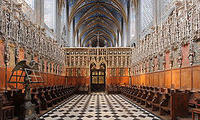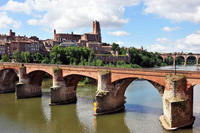You are in: Europe -> France -> Episcopal City of Albi, and traditional search or Image Gallery will yield results of this site only
Episcopal City of Albi
| Site number: | 1337 |
|
| Type of site: | Cultural | |
| Date: | 11-13 centuries | |
| Date of Inscription: | 2010 | |
| Location: | Europe, France, Region Midi-Pyrénées | |
Up to 75 images are shown here. Click on each for more details or on Image Gallery for more images.
Six official UN languages:
Arabic,
Chinese,
English,
French,
Russian,
Spanish
Other languages: Bulgarian, Catalan, Croatian, Czech, Danish, Dutch, Esperanto, Finnish, Galician, German, Greek, Hungarian, Italian, Japanese, Latvian, Lithuanian, Macedonian, Norwegian-bokmål, Norwegian-nynorsk, Occitan, Polish, Portuguese, Slovenian, Turkish, Ukrainian
Other languages: Bulgarian, Catalan, Croatian, Czech, Danish, Dutch, Esperanto, Finnish, Galician, German, Greek, Hungarian, Italian, Japanese, Latvian, Lithuanian, Macedonian, Norwegian-bokmål, Norwegian-nynorsk, Occitan, Polish, Portuguese, Slovenian, Turkish, Ukrainian
| Description: | The old city of Albi, located in southwest France on the banks of the River Tarn, became a powerful Episcopal city in the 13th century following the Albigensian Crusade against the Cathar heretics. Its lofty fortified 13th century Cathedral is built in a unique southern French Gothic style from local brick in characteristic red and orange colors, and it demonstrates the power of the Roman Catholic clergy. The nearby bishop’s Palais de la Berbie overlooks the river, and is surrounded by residential quarters dating to the 10th and 11th centuries. Together with the Old Bridge (Pont-Vieux) and the Saint-Salvi quarter, this coherent and homogenous area remains largely unchanged through the ages. --WHMNet paraphrase from the description at WHC Site, where additional information is available. | |
| Albi (Occitan: Albi) is a commune in southern France. It is the prefecture of the Tarn department. It is located on the River Tarn, c. 85 km northeast of Toulouse. Its inhabitants are called Albigensians (French: Albigeois/ Albigeoise(s)). It was the seat of the Archbishop of Albi. The Episcopal city, situated in the center of the actual city, around the cathedral, was added to the UNESCO list of World Heritage Sites in 2010. Albi was built around the original cathedral and episcopal group of buildings. This historic area covers 63 hectares. Red brick and tiles are the main feature of most of the edifices. Along with Toulouse and Montauban, Albi is one of the main cities built in Languedoc-style red brick. Among the buildings of the town is the Sainte Cécile cathedral, a masterpiece of the Southern Gothic style, built between the 13th and 15th centuries. It is characterised by a strong contrast between its austere, defensive exterior and its sumptuous interior decoration. Built as a statement of the Christian faith after the upheavals of the Cathar heresy , this gigantic brick structure was embellished over the centuries: the Dominique de Florence Doorway, the 78 m high bell tower the Baldaquin over the entrance (1515–1540). The rood screen is a veritable filigree work in stone in the Flamboyant Gothic style. It is decorated with a magnificent group of polychrome statuary carved by artists from the Burgundian workshops of Cluny and comprising over 200 statues which have retained their original colours. Older than the Palais des Papes in Avignon, the Palais de la Berbie, formerly the Bishops' Palace of Albi, now the Toulouse-Lautrec Museum, is one of the oldest and best-preserved castles in France. This imposing fortress was completed at the end of the 13th century. Its name comes from the Occitan word Bisbia, meaning Bishops' Palace. The Old Bridge (Pont Vieux) is still in use today after almost a millennium of existence. Originally built in stone (in 1035), then clad with brick, it rests on 8 arches and is 151m long. In the 14th century, it was fortified, reinforced with a drawbridge and houses were built on the piers. Albi is a well known city for its elite Lycée Lapérouse, a high school with 500 students situated inside an old monastery boasting several literature classes. Furthermore, it is one of the few holding a full scale music section with special high tech rooms for this section. Albi is the home of the Toulouse-Lautrec Museum. More than 1000 works, including the 31 famous posters, are kept within the walls. This body of work forms the largest public collection in the world devoted to Toulouse-Lautrec. --Wikipedia. Text is available under the Creative Commons Attribution-ShareAlike License. | ||
| Source: | http://whc.unesco.org/en/list/1337 | |
| Reference: | 1. UNESCO World Heritage Center (http://whc.unesco.org/en/list/1337). 2. Wikipedia. | |





























